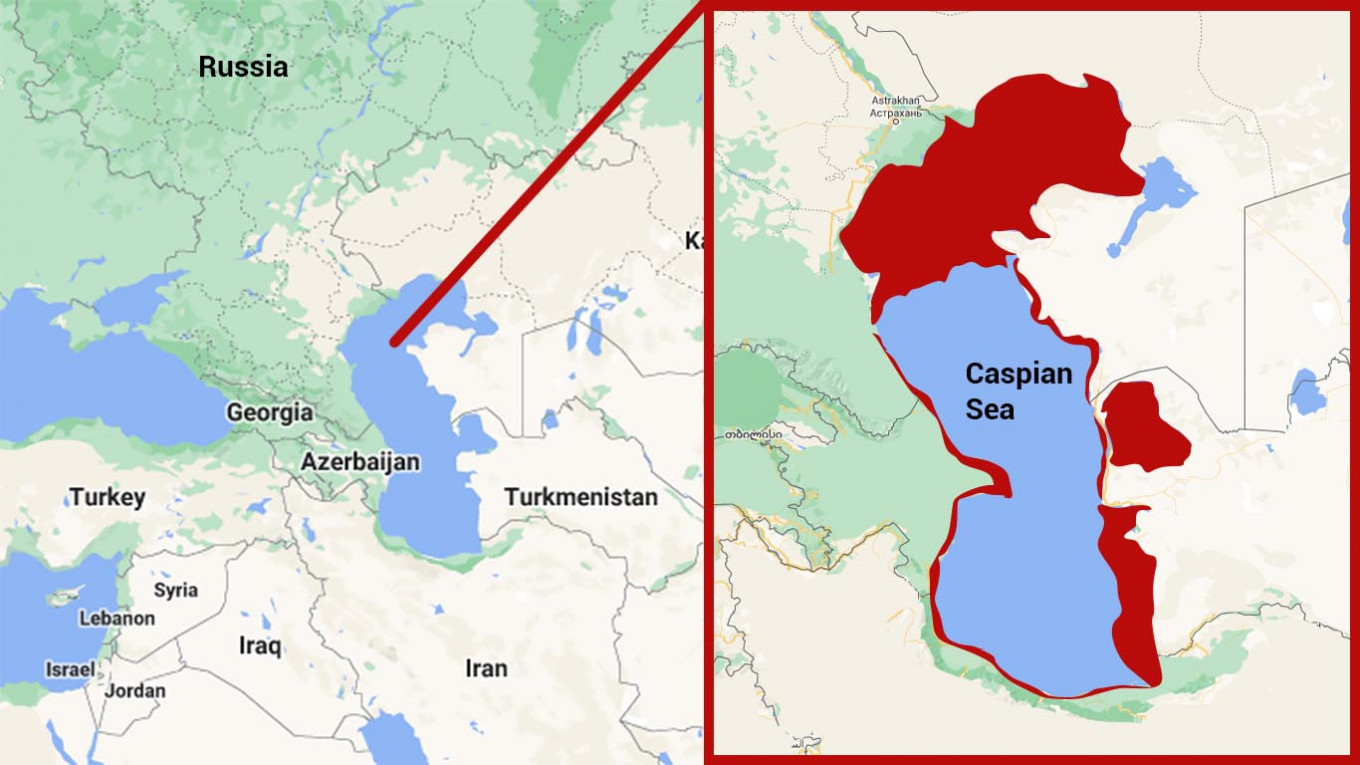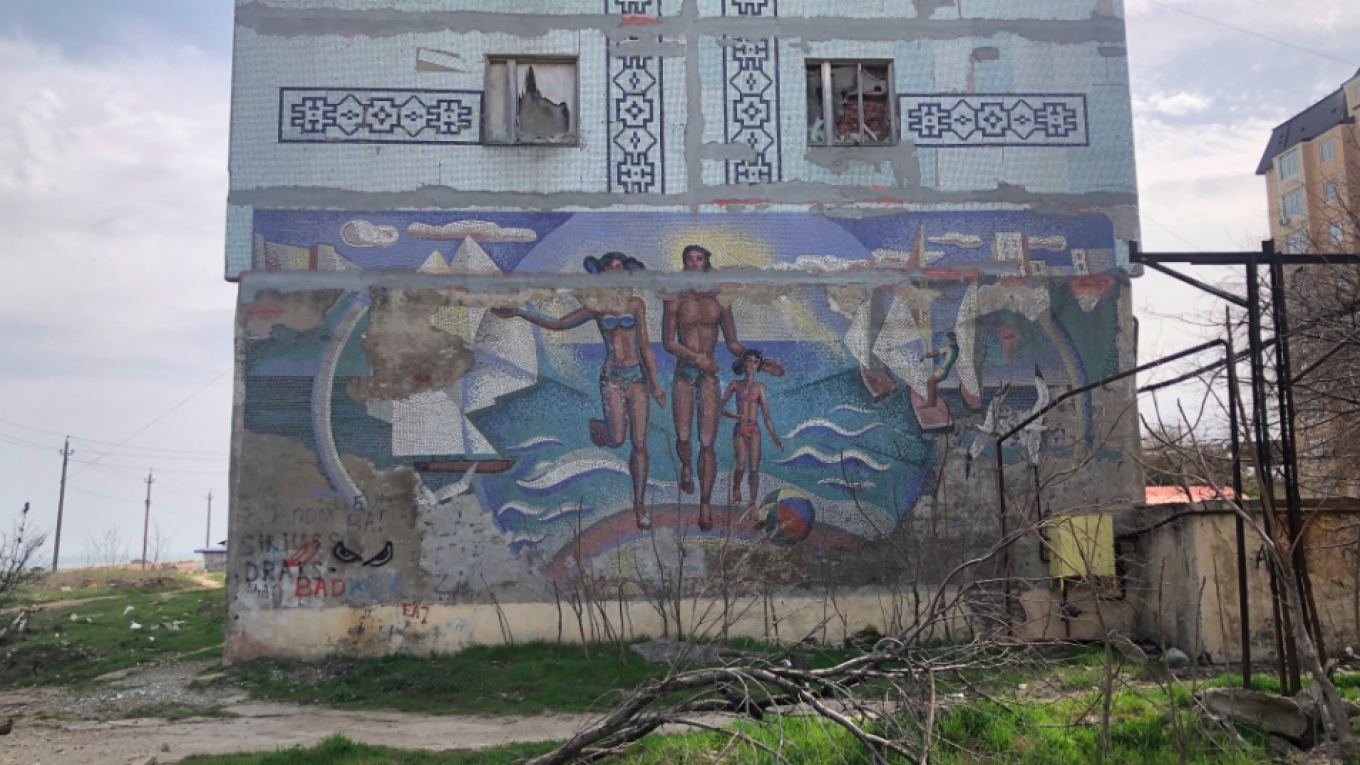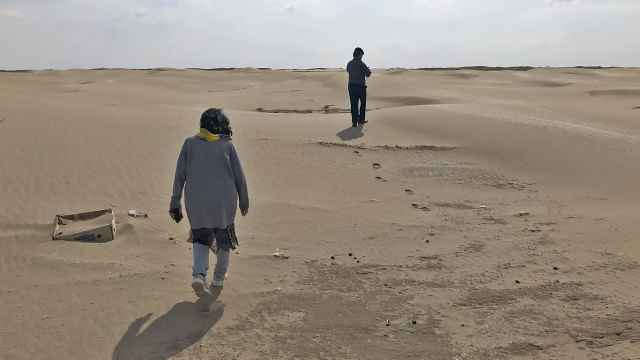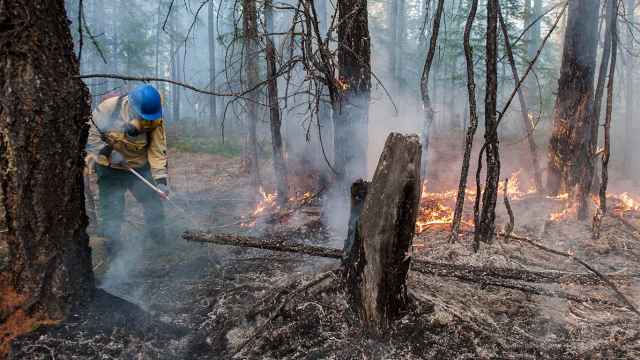DERBENT, Dagestan — At low tide, the waves on the beach fall back to expose an odd pile of rocks, half buried in the sand. Smooth and grey, some are carved into arched gateways. They are the last traces of a centuries-old tower, long hidden beneath the sea.
The walls of Derbent — an ancient Persian fortress city now at the southernmost tip of Russia’s North Caucasian Dagestan region — have always been shrouded in mystery. A popular myth has them built by Alexander the Great to seal off his empire from barbarian invasions. The intrigue is heightened by Derbent’s evocative location, straddling a narrow pass between the Caucasus mountains and the Caspian Sea.
“This is a hugely important discovery,” Murtazali Gadjiev, an archaeologist who has been excavating Derbent since the 1970s, said of the ruins, which emerged from under the waves in March. “We’re likely to find more such remnants of the city walls in future.”
“Assuming the Caspian continues to shrink, that is.”
Increasingly, scientists agree that it will. According to a series of recent studies, the Caspian — the world’s largest inland body of water — is rapidly drying up as climate change sends temperatures in the region soaring.
Having already fallen by several meters since its mid-1990s peak, the Caspian’s retreat represents a major threat to fragile ecosystems with hundreds of endemic species, and to huge areas of arid inner Asia where human life has always depended on the sea.

The Caspian Sea — a vast body of landlocked saltwater around the size of Norway stretching from Russia in the north to Iran in the south and dividing Central Asia from the Caucasus — has always behaved unpredictably.
Throughout history, a complex cocktail of climatic shifts and tectonic movement have driven sharp, unexpected fluctuations in the sea level, with coastal cities alternately threatened with deluge or left stranded far from the shore.
Even today, the ancient Silk Road port of Abaskun in northern Iran is missing, presumed lost during a rapid rise in the sea’s level in the Middle Ages.
During the last century, the Caspian has been especially fickle. In the 1930s, the damming of the Volga River — from which around 80% of the Caspian’s water flows — to fuel the Soviet Union’s rapid industrialization saw the sea’s surface collapse by two metres in five years. Within a few decades, however, increased rainfall along the Volga saw the Caspian unexpectedly swell, hitting near-record highs by the 1990s.
For residents of Dagestan’s coastline, adapting to the Caspian’s twentieth century see-saws has become a familiar, if unpredictable, rhythm of life by the sea.
“Thirty years ago, the waves were actually starting to wash away buildings,” said Zaur Mullaev, a 65-year-old pensioner walking on the beach at Derbent.
“Back then, we were all worrying about how we’d protect the town.”
New sand dunes
In 1996, however, the tide turned. That year, a sustained and rapid decline in the Caspian Sea level began, continuing up to the present day.
In Derbent, waves that once threatened to engulf entire streets have retreated by around 100 meters, leaving miles of fresh sand dunes up and down the former shoreline.
While previous Caspian fluctuations were driven by unpredictable combinations of human and environmental factors, this decline — which has been accompanied by record high temperatures in landlocked inner Asia — has a more straightforward cause, say scientists.
“This time, it’s about climate change,” said Eldar Eldarov, a geography professor at Dagestan State University.
“The same amount of water is still reaching the Caspian from the Volga, but higher surface temperatures mean more water is evaporating from the sea.”
It’s a theory gaining ever more weight among the scientific community. According to a 2020 study, the Caspian — whose level has been falling by around seven centimeters a year since 1996 in tandem with rising temperatures in the Caspian basin — is projected to lose up to 18 meters of depth by the end of the century.
Under this scenario, around a quarter of the Caspian’s current surface area is set to dry up entirely, leaving behind 93,000 square kilometers of new deserts, similar to those created in parts of Central Asia by the Aral Sea’s evaporation.
“Usually, when lakes or inland seas decline, it’s a combination of human activities like agriculture and underlying climatic factors,” said Matthias Prange, a climatologist at the University of Bremen in Germany and co-author of the 2020 study on the Caspian.
“However, in the case of the Caspian, it’s almost entirely about climate. The sea’s decline is driven overwhelmingly by rising temperatures.”
Though the Caspian — parts of which are over a kilometer deep — is unlikely ever to retreat to the extent of the near-vanished Aral Sea, the prospect of rising temperatures forcing the sea level down does mark a potential turning point.
Where once the Caspian ebbed and flowed over time, allowing both humans and ecosystems to adapt, sustained warming could irreversibly shrink the sea, permanently jeopardizing both.

Along the Dagestani coast, the vanishing sea is making its absence felt throughout daily life.
In Kaspiysk, a port named after the sea, fishermen complain of chronic industrial pollution killing off catches in waters that recede two or three meters further from the harbor each year.
In some cases, the sea’s retreat has precipitated a flurry of activity, as businesses struggle to adapt to the ever-lower tides.
“Since we started here fifteen years ago, the shoreline has shifted by about seventy meters,” said Ali Amirkhanov, owner of the town’s Djami hotel, a beachside resort built on land reclaimed from the receding sea.
“Almost every year we have to put up another row of umbrellas on the beach, as the water gets further away.”
With the falling sea level leaving loose sand exposed to the strong Caspian winds, Amirkhanov has had to buy in huge quantities of sand, with diggers working year round to build a beach where the seabed once lay.
Despite the danger of Dagestan’s major cities being stranded miles from the sea, in many ways the region — which borders on an especially deep section of the Caspian — is sheltered from the likely worst consequences of the sea’s retreat.
Much of the sea’s shallow eastern reaches — including the northeastern gulf that juts into Kazakhstan — are projected to evaporate entirely as temperatures rise.
In resource-rich western Kazakhstan, the Caspian’s collapse is already imperilling the giant Kashagan offshore oil field, with the sea level now so low that support vessels are unable to reach drilling platforms.
More generally, a shrinking Caspian is likely to wreak havoc on the region’s already unforgiving climate.
Having exerted a moderating influence on inner Asia’s otherwise hot and dry weather, the Caspian’s decline — like that of the Aral Sea before it — threatens to accelerate local climate change as the sea’s cooling effect, and the rains it generates, begin to fade away.
“Our models show that even a limited reduction in the Caspian Sea has a major impact on the region’s climate,” said Bremen University's Prange.
“We’re likely to see summers in the Caspian region, in particular in Central Asia, become significantly hotter and drier. And this is a region that even now faces serious issues with water shortages.”

Yet despite the Caspian’s struggles, very few in Dagestan admit to worrying about the decline of a sea that has always defined the region’s economy, from oil extraction to fishing and agriculture.
For Russian public opinion, environmental issues traditionally play second fiddle to economic concerns. Dagestan is one of Russia’s poorest regions, long plagued by terrorism and crime, and the Caspian is an especially low priority problem.
Moreover, with much of the wider Caspian basin suffering chronic drought, there are even proposals to drain the sea further, in order to supply water to Iran’s parched central provinces.
For many locals the last century of sea level fluctuations has given rise to the misconception that the Caspian has always been subject to a cycle of regular expansions and contractions, and that this decline is nothing out of the ordinary.
“These cycles are a unique trait of the Caspian,” said resort owner Amirkhanov, who believes the sea will begin rising again in the coming years.
“It rises for twenty five years, then falls for twenty five years. There’s a fifty year cycle.”
Even among the local scientific community, there is a reluctance to embrace the bleakest forecasts for a sea on which Dagestan has always depended.
“The Caspian is a complex system,” said geographer Eldar Eldarov. “We don’t fully understand how climate change will affect it.”
“After all, there’s still a chance that the sea will come back one day.”
A Message from The Moscow Times:
Dear readers,
We are facing unprecedented challenges. Russia's Prosecutor General's Office has designated The Moscow Times as an "undesirable" organization, criminalizing our work and putting our staff at risk of prosecution. This follows our earlier unjust labeling as a "foreign agent."
These actions are direct attempts to silence independent journalism in Russia. The authorities claim our work "discredits the decisions of the Russian leadership." We see things differently: we strive to provide accurate, unbiased reporting on Russia.
We, the journalists of The Moscow Times, refuse to be silenced. But to continue our work, we need your help.
Your support, no matter how small, makes a world of difference. If you can, please support us monthly starting from just $2. It's quick to set up, and every contribution makes a significant impact.
By supporting The Moscow Times, you're defending open, independent journalism in the face of repression. Thank you for standing with us.
Remind me later.







